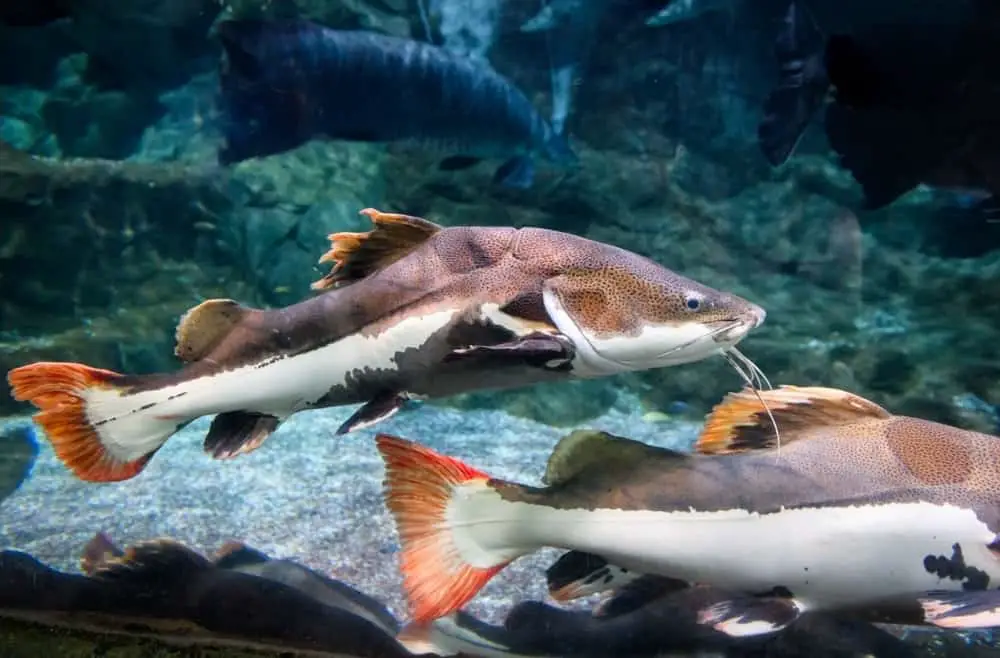The kryptopterus vitreolus (or Glass Catfish), sometimes known as the Ghost Catfish, is a small freshwater glassfish species native to Southeast Asia.
Vitreous is derived from the Latin word “vitreus,” which means “glass,” and the Greek word “Kryptos,” which means “hidden”. The spines of this catfish family, which belongs to the Siluridae family, do not extend past their dorsal or adipose fins, and their dorsal fins may be tiny or absent entirely.

Care Guide
Tank Size
Glass Catfish require at least a 30-gallon tank. They require adequate space to school and swim together as they see fit. Because they are so shy, the larger aquarium allows them to feel more secure in their surroundings. They will thrive in a tank of at least 30 gallons. This offers them lots of areas to swim in the tank’s central regions, as well as plenty of space to hide if they get scared. Check that the tank is well-planted.
Tank Mates
There are a lot of glass catfish tank mates to pick from. These fish do well in community aquariums where they can coexist with a variety of other creatures.
When it comes to choosing good glass catfish tank mates, the two things to look for are size and aggression. Larger fish can be a problem since they may consider your glass catfish to be a snack!
Aggression should also be avoided because the mild demeanor of ghost catfish will work against them. They are simply too peaceful to speak up for themselves. To get you started, here are some wonderful glass catfish tank mates:
- Kuhli Loach
- Cory catfish
- Swordtails,
- Molly fish
Same Species Tanks
The Glass Cat is a calm, shy, and sensitive fish. It should only be kept with tranquil tank mates and in a school of at least six. They thrive in larger, well-planted aquariums with plenty of hiding places. If they are maintained with aggressive mates or in a tiny school, they will turn white and die from stress.
Water Parameters
When it comes to tank conditions, they are equally as sensitive to water parameters as their name implies. They do not react well to temperature, pH, or other chemical changes. These figures are more of a requirement than a guideline. These fish will begin to perish if they begin to change.
- Temperature range: 75-80°F
- KH 8-12 hardness
- pH range: 6.5-7.0
- Moderate water flow
These fish are more difficult to care for than other easier starter species due to the tight water parameters they require.
What To Put In Their Tank
It is essential to use the best and/or correct filtration system when caring for your fish. It’s exciting to build and set up your aquarium and collect all the exotic plants and rocks, but the filtration system should be your primary focus.
Bigger is preferable in this scenario. Some filters are fixed, while others can tolerate a variety of tank sizes. Make sure you obtain one that is rated for 30 gallons or more (since that is the least size you should have for glass catfish).
Common Diseases
If you only look at the recommended water requirements for glass catfish, it can be a little scary, but it’s all up from there. When it comes to these fish, there are no species-specific diseases to be concerned about.
Just make sure to provide them a well-balanced diet of high-quality foods and keep their water clean. You will considerably lessen the likelihood of them having any of the typical health issues that affect freshwater fish if you do this.
Food & Diet
Glass catfish diets in captivity should be as close to their natural diet as feasible. This will be accomplished through the use of a range of food sources in order to achieve a well-balanced diet.
A high-quality flake or pellet meal is a good place to start, and it’s something you’ll be giving them on a daily basis. This food will be the foundation of their diet, ensuring that they acquire all of their vital nutrients.
High protein sources such as bloodworms, brine shrimp, and daphnia are also excellent complements. You don’t want to feed this to your ghost catfish too frequently, but once or twice a week is good. This ensures that kids receive additional enrichment from the variety and that they are never too hungry.
Lifespan
With good care, Glass Catfish can live from 7-8 years in captivity.
Appearance
The glass catfish’s most appealing feature is its one-of-a-kind appearance. These fish are completely translucent, as the name implies. The primary advantage of this is that it makes them more difficult for predators to find, similar to ghost shrimp. They are almost shockingly transparent at first. You can easily view all of their inside organs and what is going on in their system.
One of the most noticeable features of these fish is their spine. You can see their entire spine, which extends from their head to the base of their caudal fin since they’re so clear. While swimming, it’s nearly hard to see their fins. Looking at images is a better approach to acquire a sense of the situation.
While swimming, it’s nearly hard to see their fins. Seeing photos of them is a better approach to understanding their structure. The caudal fins of ghost catfish are forked and there is no dorsal fin. Their little pectoral fins provide the majority of their vertical motion, and if you look closely, you may see them swimming swiftly.
Their internal organs are also clearly apparent. They are located behind their eyes, near the base of their pectoral fins, and appear to be a dark silvery mass. Glass catfish have barbels that protrude straight out from their heads, as opposed to other catfish, which have barbels that fall back behind them while swimming.
Size
There are several species of Glass Catfish, the most common of which are Kryptopterus vitreous and Kryptopterus Bichirris. The biggest distinction between the two is their size; K. Minor is 2.5 inches long, whereas K. Bichirris can grow to be 6.5 inches long. K. Minor is a stunning catfish with a missing dorsal fin and a lack of body coloration.
Behavior & Temperament
They truly add something special to your tank. Glass catfish are a terrific addition for everyone from new fish owners to hobbyists to seasoned aquarists.
Glass catfish can be fairly lively, and unlike most other catfish species, they do not loiter at the bottom of the tank. They enjoy free swimming and will normally swim around in the center of your tank.
They are calm, get along well with other fish, and thrive in community tanks. They keep to themselves, and you may find them hidden among the plants and other decorations in your tank to avoid direct sunlight.
Breeding
These fish reproduce during the monsoon season in their native Thailand. However, how they breed in a tank remains a mystery. Although there have been a few accounts of individuals successfully reproducing them in captivity, the rate is not very great. Make sure you have at least one of each sex.
It’s tough to identify the difference between male and female glass catfish because the females are only slightly larger and have a slightly larger belly for eggs.
The easiest technique to try to recreate a proper breeding environment in the tank is to drop the temperature to roughly 23 degrees Celsius (73 degrees Fahrenheit), then add some freshwater every day (not too much).
This gives the impression that rainfall is being added. This is also what may lead the fish to feel that it is the rainy season and that it is time to start mating.
You can get the fish to reproduce by doing everything you can to make them feel at ease (in their natural environment). This includes ensuring that there is plenty of live food available at this time.
The live food will give your glass catfish the energy it needs to pair. Make sure your aquarium has plenty of plants since female catfish will lay their eggs on the surface of these plants. The young glass catfish, despite its small size, will be able to consume tiny morsels of food and baby brine shrimp.
Gender Differences: Male vs Female
It’s tough to identify the difference between male and female glass catfish because the females are only slightly larger and have a slightly larger belly for eggs. The only way to know for sure is to check their anatomy.
Fun Facts
- These fish are sensitive to bright light. We bet you wouldn’t enjoy it if you didn’t have any pigmentation.
- They might be picky eaters, so be sure the pet store offers the right food for them. They don’t usually like flakes, however, they may prefer freeze-dried food. Placing the food near a current (from the filter) to resemble real prey is an effective approach to entice them to eat.
- They are affected by electromagnetic fields. This has the ability to uncover and solve all of our questions about neurological illnesses including Parkinson’s and epilepsy. Studies on mice have been conducted in which the EPG gene (electromagnetic perceptive gene) is administered non-invasively; this is the same gene that may one day aid with tremors in a person’s limbs.








